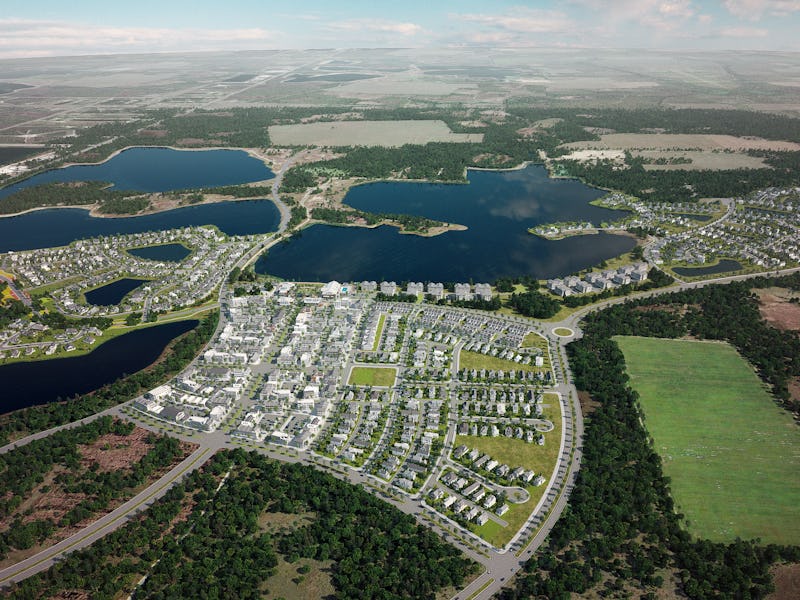Solar Energy-Loving NFL Vet Syd Kitson Is Building the Smartest Town in Florida
The plan for America's first solar-powered community is ambitious, to put it mildly.

Syd Kitson is a Green Bay Packer turned Dallas Cowboy turned Florida real-estate investor and city planner. For the past ten years, his firm has been working on Babcock Ranch, a planned community of 19,500 homes that will be the first American town solely dependent on solar energy when construction, which begins this summer, is completed. Kitson wants it to be a livable, pleasant place, but that’s not all. Kitson sees Babcock ranch becoming the Southeastern Menlo Park, a sort of Silicon Glade. He hopes the sun does more than power the town-wide gigabit wifi coverage, which in turn allows residents to use the Babcock Ranch app, designed to be the ultimate helpful neighbor. He hopes the sun brings smart people, talented people, and people willing to imagine a different way of living.
Kitson wants to build the small town of the future. Just don’t call it a utopia. He hates that.
The Babcock Ranch project began ten years ago, immediately before the housing bubble burst. Timing wasn’t great, but Kitson and his team refused to give up on their vision for a better, smarter Florida. “I think what the NFL taught me, and my football career taught me, was the value of hard work and truly never giving up,” Kitson says. Good thing, too. Local officials were not particularly excited about what Babcock Ranch might mean for the local electrical grid.
And now, that hard work and persistence is beginning to pay off: “We are starting construction on the homes this summer.” The general infrastructure, of which there is a lot, is already being installed; they’re beginning to put together the town square. “We’ll be opening the doors for people to live there first quarter of next year,” Kitson says.
In many ways, Kitson explains, Babcock Ranch is designed to imitate the sorts of small towns common in New England, the Mid-Atlantic, much of the Midwest, and Hollywood films set in the fifties (think: Bedford Falls, Pleasantville, or Elmore City). The town will be walkable with over 50 miles of trails on which residents can hike to their hearts’ content. There’s a general store, itself replete with a cafe and ice cream shop. Not to mention the neighboring nature preserve: as part of the deal, Kitson convinced then-Governor Jeb Bush to purchase and preserve 73,000 acres with state funding. Babcock Ranch itself takes up about 18,000 acres.
Babcock Ranch's town square.
While this town in part looks at historical archetypes to inform its design and functionality, it primarily looks to the future. Babcock Ranch seeks to embody and then supersede those archetypes. Kitson says that they’re currently “in negotiations with a major tech company right now that wants to interconnect everything” within the community. “Everything: from your utility plan to education to health and wellness to our traffic patterns to our transportation. All things critical will be interconnected.”
Kitson says that, from “a tech perspective, we just have almost unlimited potential in what we can do.” There’ll be an electric vehicle autonomous transportation system that you can access through the Babcock Ranch app that’ll take you anywhere within town limits. (There’ll also be EV charging stations all over the place for those with their own EVs.) The “middleware” app will also give you customizable hike suggestions and recreational ideas — it’s meant to be a “one-stop shop” that can meet the community’s each and every need. Given the blanket fiber-optic gigabit wifi, Babcock Ranch will be able to support telehealth, actually smart homes, and unsurpassed — think 360 video — live-streaming.
“Now, have we future-proofed it? I have no idea,” Kitson says, laughing. “The best thing we can figure out is fiber, and all the applications that come from that. But, gosh … who the heck knows what’s going to be around the corner.”
Of course, all these innovative technological options are nothing more than that: options. If you want to live on Babcock Ranch and would prefer that your home be dumb as a non-IoT-connected doorknob, Kitson says that’s just fine. If you prefer your home to be a relative genius, it’ll be set up for you to boost its figurative IQ. “It’s going to be totally up to the consumer,” he says.
Lakefront properties.
Despite the utopian elements of this town, Kitson says it doesn’t belong to the grand American tradition of ideologically-driven planned communities. (It’s worth noting that tradition also involves an inevitable unraveling and quite a lot of infighting. Many wills mean few agreements.)
“We don’t require people to do things,” he says. “We’re giving them the venue to do those things that they want. So, yes, it’s going to be one of the healthiest new towns that’s ever been designed, and you’re going to have an opportunity to use our health and wellness center, to walk to the downtown, to eat healthy, farm-fresh, homegrown foods — you’ll be able to do all those things.”
“However,” he adds, “if you want to go to McDonald’s and have a Big Mac, you can do that, too.”
Prospective homeowners will also have great freedom in determining where they live and how luxurious their homes will be. You can set up shop “in a townhouse or an apartment in the downtown area” or, alternatively, “on the edges, with a larger lot in one of the hamlets where you have a little bit more privacy. There’s going to be a real stratification of pricing and products, from $250,000 up to multimillions. And everything in between.”
A solar-powered, interconnected, smart town: it’s “never been done before,” Kitson says. No matter how much larger cities and towns want to modernize, they “all have legacy issues. When you see how they’re run, they’re basically in silos.”
When you start from scratch, though, you can do whatever you want.